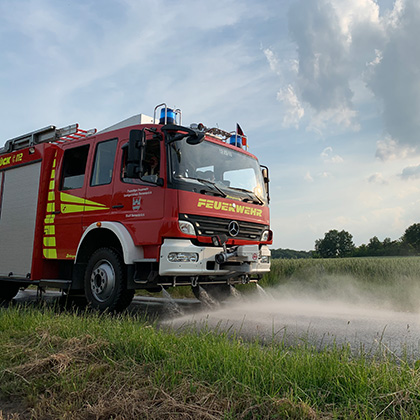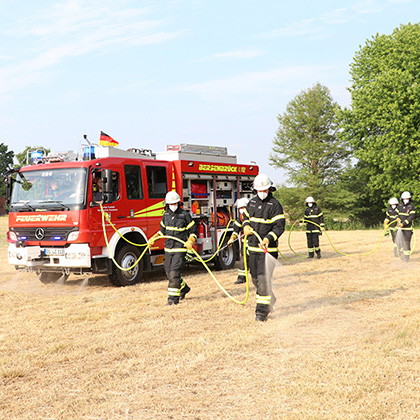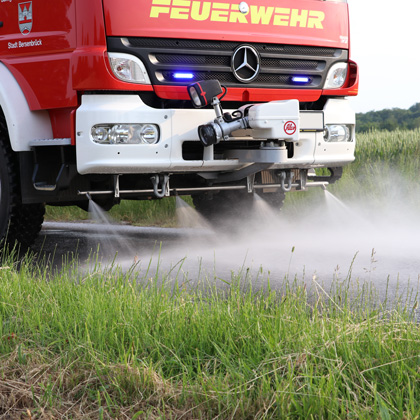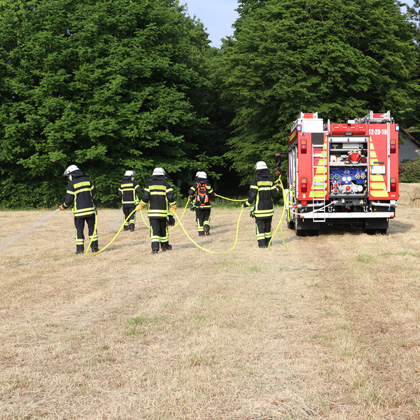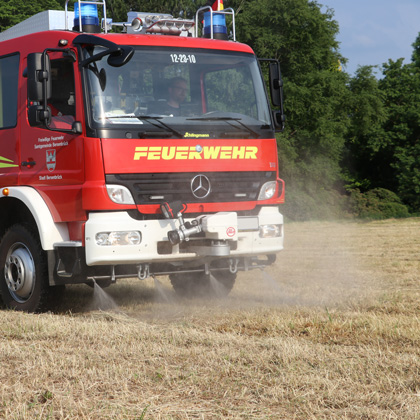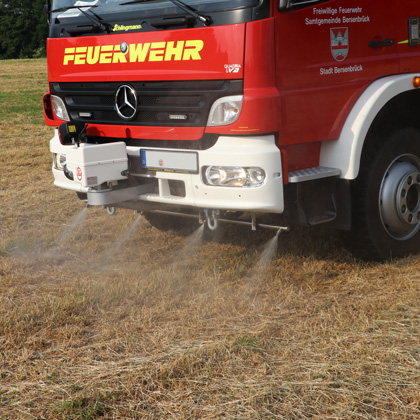The Bersenbrück fire fighters have fitted their tactical approach with respect to vegetation fire to the current state of the art and training in order to fight such types of fire by mobile firefighting attacks in a pump-and-roll operation from this moment forth. To this end, additional wildfire equipment in line with DIN14800-10 was acquired for two fire trucks (LF 16/12 / TLF 16/25). This concept has now been complemented by a bema front spray bar designed to protect the TLF 16/25 itself.
This bema front spray bar was mounted under the front bumper and shall ensure dousing resp. moistening the soil under the vehicle while driving in green or black zones. The 70-degree spray angle enables covering the entire vehicle width. With their 3-bar pressure, four nozzles provide 30 litres per minute each. When operating the spray bar along with two D jet pipes spraying 50 litres/minute, a tank capacity of 3,000 litres enables extinguishing a fire hem of approximately 750 to 1,000 meters.
The spray bar is entirely made of stainless steel, all components are dimensioned to withstand minimum pressure of 16bar. Mounting, including laying a rigid pipe to the vehicle rear end was ensured by the Bersenbrück fire fighters themselves and took them some four hours. Commissioning was ensured via a C-DCD distributor directly mounted on the pump discharge side by means of a 2-meter D-pipe. For trial purposes and in order to minimise costs, a spray ramp having neither lockable nozzles nor an additional D discharge were integrated in the first instance, if necessary, these will be added later on. As cost-efficient refitting solution, bema front spray bars are manufactured by bema on a customised basis in line with the customer’s specific requirements and requests.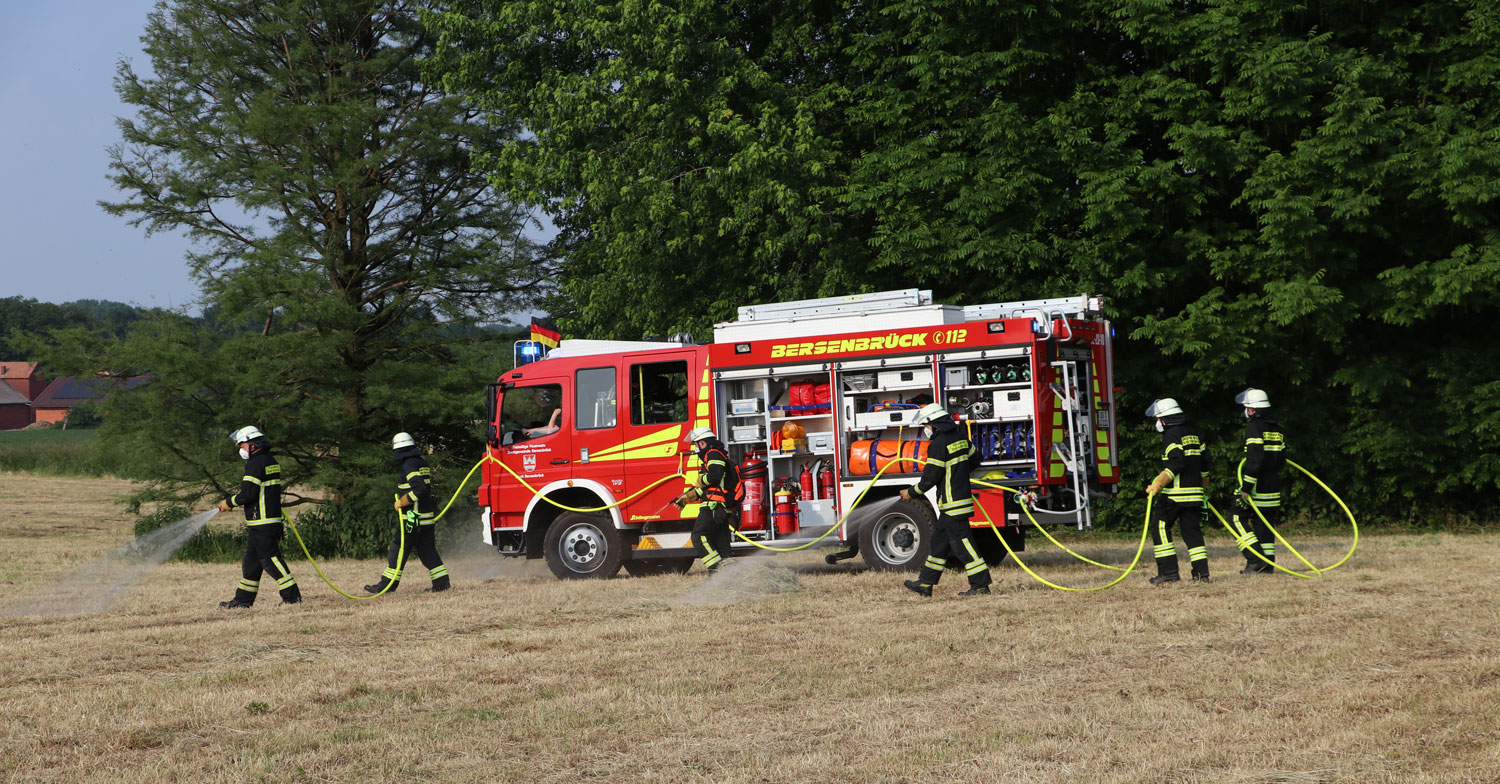
Picture: On-the-job-training: fighting vegetation fire, Bersenbrück fire fighters practising the use of the new bema front spray bar mounted on the TLF 16/25.
From idea to implementation
"The hot summer 2019 having entailed a multitude of large-scale fires taught us that we have to adapt our tactical approach to the new conditions“, says deputy local fire officer Thomas Wurst when receiving the spray bar from the development association.
"Our fire truck standard equipment including B and C jet pipes does not offer us sufficient mobility in the event of large-scale fire, furthermore, flow rates are over-dimensioned with respect to small fire load, therefore, we needed a better solution,“ explains is brother Christian, President of the development association.
The solution to this problem is the so-called mobile fire-fighting attack consisting of fire trucks running over the surfaces with their pumps in operation, while fighting fire by means of small and light D jet pipes and D hoses. This tactical approach is very mobile and better games on firefighting water, entailing new problems, though.
“When moving on the zone which has not been burnt, there is a risk of ignition of the underground due to the vehicle hot exhaust gas system or in case the wind should turn, we might even be caught up by the fire. Where we move in a burning resp. already burnt zone, the so-called black zone, there are pockets of embers, small flame hems and rests of combustible materials which might burst into flames at any time, thereby damaging the vehicle“, explains press relations officer Stefan Uphoff.
Christian Korfage, vehicle engineer and section commander, had the idea to refit the vehicle with a spray bar. “Our vehicles are not made for driving over fire. A compressed air conduct having started to melt under the chassis suffices to paralyse the vehicle and its pump. Should fire continue to burn under the vehicle, this can very quickly come to a bad end. The front spray bar enables us to extinguish and to moisten the zone under the vehicle, thereby protecting our vehicle in the long run.”
The development association had contacted bema GmbH Maschinenfabrik - the refitting solutions specialist company in Voltlage-Weese and its managing director Sonja Koopann was immediately red-hot about the idea. “We are always happy when someone has an idea and we can then develop something together on this basis.“ Following a first contact, things evolved very quickly then: technical details were agreed upon, in particular the choice of nozzles offering the right ratio of flow rate to spray angle. Shortly afterwards, the spray bar was already finished.
“For the time being, we kept things simple, there are also spray bars equipped with nozzles with shut-off facilities on an individual basis and additional D discharges, but we do without these for now“ says Christian Korfage. “We integrated these elements as a personal contribution, including laying a conduct from the vehicle rear to its front end, this took us a Saturday morning. All we still need to do in order to put the bar into operation, is to connect a short D conduct to the pump.”
Sonja Koopmann explains “An additional discharge or shut-off nozzles are no problem for us, our production line is in a position to flexibly react on our clients’ requests. We made all components of stainless steel and dimensioned them to withstand minimum pressure of 16bar. This product actually fits very well into our portfolio as a manufacturer of power sweepers and cleaning devices. Should any other fire brigades need such a solution, we would be very happy to answer their enquiries.
“It would have been too expensive to have a front spray bar be mounted with the manufacturer and what is more, the vehicle would have been idle in the manufacturer’s garage for several days, this solution offered by Bema war clearly less complicated.“ sums up Christian Wurst.
“In the future, we shall surely also use the front spray bar for cleaning the streets“, says Thomas Wurst. “Properly speaking, this is not our actual work as fire fighters, but it happens from time to time. I very well remember a malodorous mission on the ring road B686 in 2012. A road tanker transporting putrescent liquid eggs had overflown, the stinking egg mass had spread all over the driving surface. We splashed the mass from the street, using steel pipes, then, we had to clean our vehicles and our protection equipment from the liquid eggs. Now, we could remove such liquids far more efficiently.”
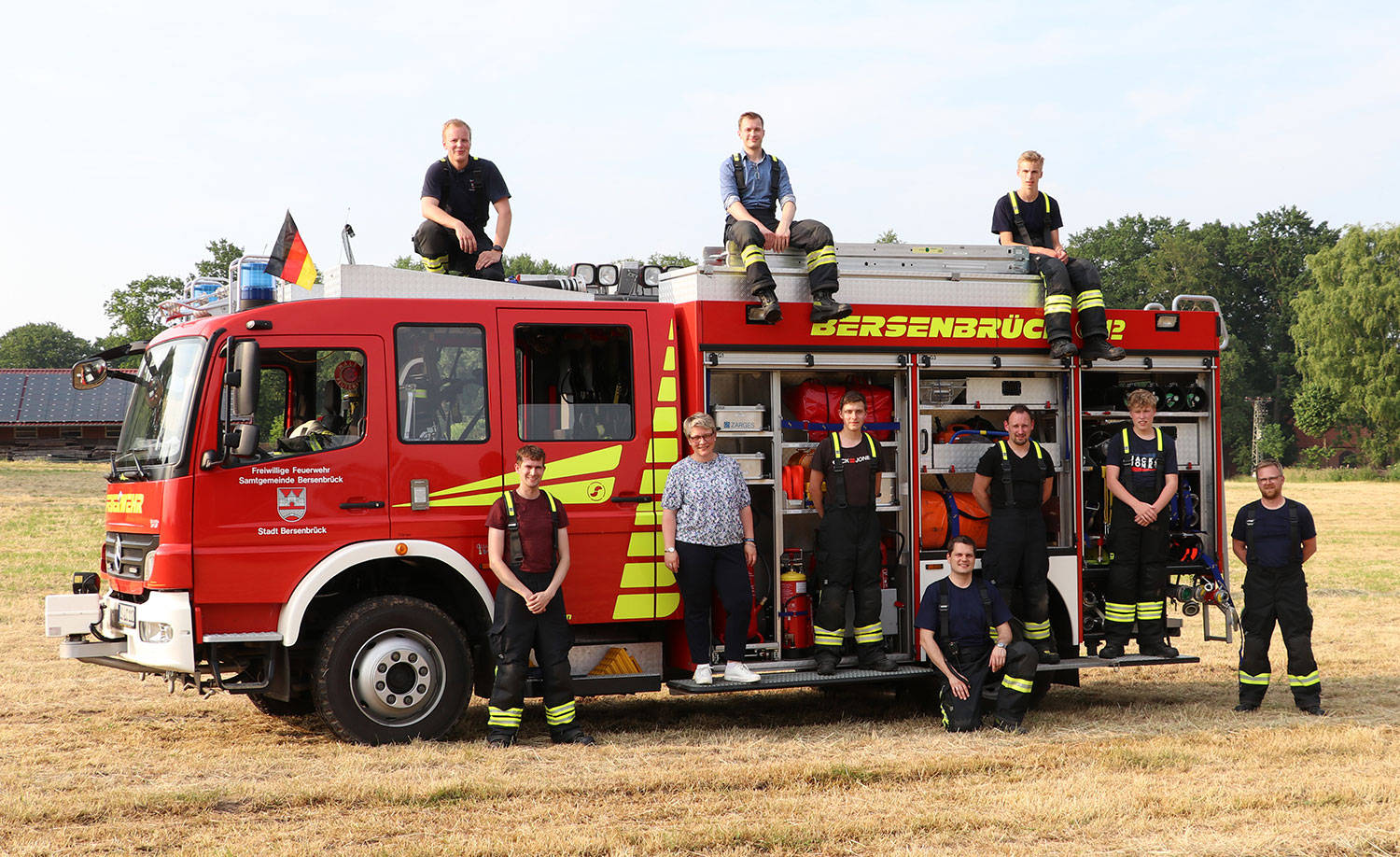
Picture: Sonja Koopmann during the first Bersenbrück fire brigade mission using the refitted bema front spray bar
You are interested in refitting your fire truck?
Then, we will be happy to answer your enquiry.
